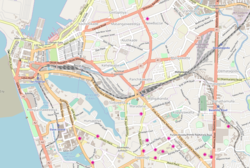History
The building was originally built by J. H. Meedeniya Adigar, which he named Rickman House. It was the home of D. R. Wijewardena (the founder of the Lake House newspaper group), who married Meedeniya's eldest daughter Alice. [1] [2] The property is relatively unique as its land title, under the original old Dutch deed, extends down to the ocean, only one of a few such cases in Colombo. [3]
In 1903 the building was purchased by Wijewardena's mother, Helena, who subsequently demolished the existing residence and rebuilt a new dwelling, Sri Ramya. [4] The new dwelling was designed by Herbert Henry Reid. [4] Wijewardena occupied the residence until her death in 1940. In May 1934, the Indian poet, Rabindranath Tagore and the Indian painter, Nandalal Bose, stayed at the house for a fortnight, when Tagore brought a troupe of Bengali dancers to Ceylon.
In 1951 the building was purchased by the Government of the United States to serve as the chancery of its Embassy in Sri Lanka. [4] It functioned in that capacity until the United States Embassy moved to a new premises in 1984 and the building was transferred to USAid, for use as their offices. [5] [6]
This page is based on this
Wikipedia article Text is available under the
CC BY-SA 4.0 license; additional terms may apply.
Images, videos and audio are available under their respective licenses.
